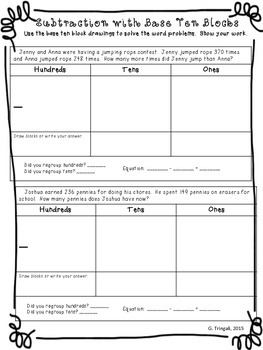
Subtraction with regrouping lesson - Math Topics. Our fraction worksheets cover a range of skills, from simplifying fractions to adding and subtracting fractions with different denominators. Worksheet Extra Practice: Three-Digit Addition with Regrouping Worksheet Addition Regrouping Worksheet Math Notes: Three-Digit Addition Worksheet Coral Reef: Three-Digit Addition with Regrouping Worksheet Add It Up! Three-Digit Numbers Worksheet Place Value: Expanding Numbers #2 Worksheet Partial Sums Worksheet Three-Digit … Fraction Worksheets - Common Core Sheets. Search Printable Three-Digit Addition and Regrouping Worksheets …. This math worksheet was created on and has been viewed 414 times this week and 6,348 times this month. Welcome to The Subtracting 3-Digit from 3-Digit Numbers With Some Regrouping (49 Questions) (A) Math Worksheet from the Subtraction Worksheets Page at. On practising these worksheets, children would learn the place value worksheet of numbers from 100 … Subtracting 3-Digit from 3-Digit Numbers With Some Regrouping …. Place value understanding is most important for addition and subtraction. Subtracting with place value blocks (regrouping) CCSS.Math: 2.NBT.B.7, 2.NBT.B.9, 3.NBT.A.2 Google Classroom About Transcript Sal uses place value blocks to regroup … 3-Digit Place Value Worksheets | Printable Math Worksheets. These worksheets include pre-made piles of base ten blocks that students can practice regrouping.Subtraction with regrouping using place value blocks worksheetsSubtracting with place value blocks (regrouping) - Khan …. The answer to the addition question, therefore, is 1,261. Trading 10 of the flats for one block gives you your final piles of 1 cube, 6 rods, 2 flats, and 1 block. Trading 10 of the rods for one flat results in 1 cube, 6 rods, and 12 flats. Trading 10 of the cubes for 1 rod means you now have 1 cube, 16 rods and 11 flats. After representing both numbers with base ten blocks and combining the piles of like base ten blocks, you should have a pile of 11 cubes, a pile of 15 rods, and a pile of 11 flats. To illustrate this procedure, picture the addition question, 568 + 693. To read the resulting number, count the number of base ten blocks left in each pile and read the number. Trade any groups of 10 rods for a flat then trade any groups of 10 flats for a block. Next, trade any groups of 10 cubes for a rod. Put all of the cubes from both numbers in the same pile do this with the rods, flats, and blocks as well. To add two or more numbers, start by representing each number with base ten blocks. One simple use of base ten blocks that translates well to a paper and pencil method of addition is to add by regrouping. A block looks like ten flats piled one on top of the other and bonded together. A flat looks like one hundred cubes place in a 10 x 10 square and attached together. Flats, as you might have guessed, represent hundreds, and blocks represent thousands. Rods represent the tens place and look like ten cubes placed in a row and fused together.

Cubes represent the ones place and look exactly like their name suggests - a small cube usually one centimeter by one centimeter by one centimeter.

In this example, the place value of the ones place is 5.īase ten blocks turn the base ten concept into something children can see and touch.īase ten blocks consist of cubes, rods, flats, and blocks. The only possible digits that could go in each place are the digits 0, 1, 2, 3, 4, 5, 6, 7, 8, and 9. For example, in the number 345, there is a hundreds place, a tens place and a ones place. This essentially means that you can only use ten unique digits (0 to 9) in each place of a base ten number. The numbering system that children learn and the one most of us are familiar with is the base ten system.


 0 kommentar(er)
0 kommentar(er)
